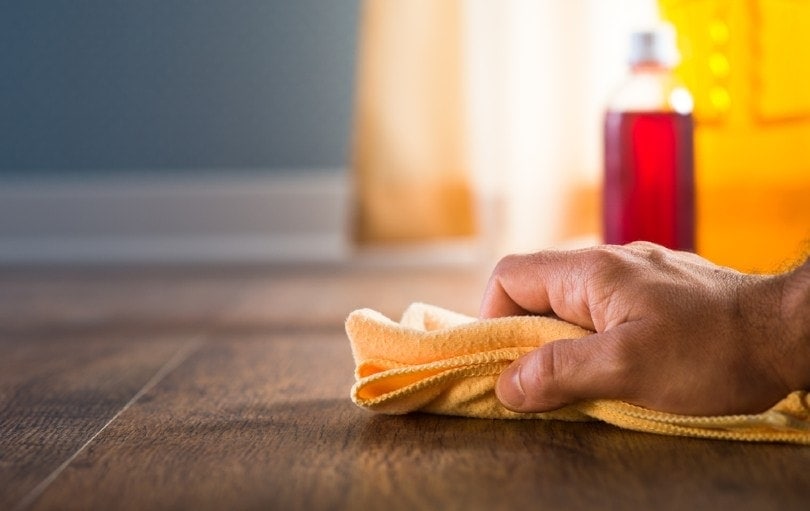
Beyond the unsightly appearance and unpleasant odor, urine can seep into the porous surface of hardwood, potentially causing long-term damage if not addressed promptly and effectively. In this article, we’ll explore the best methods and techniques to remove urine from hardwood floors, ensuring a clean and odor-free living environment.
I. Introduction
A. Understanding the challenge: urine on hardwood floors
The presence of urine on hardwood floors can be a cause for concern due to its potential to seep into the wood, causing discoloration, warping, and odor. Unlike other surfaces, hardwood requires specialized care to ensure proper removal without causing further damage.
B. Importance of prompt and proper removal
Prompt removal of urine from hardwood floors is crucial to prevent lasting damage and lingering odors. Failure to address the issue promptly can result in permanent stains, odors, and even structural damage to the wood.
C. Overview of methods to effectively get urine out of hardwood floors
There are several methods and techniques available to effectively remove urine from hardwood floors, ranging from natural remedies to commercial cleaning solutions. Understanding these options and how to apply them correctly is essential for successful cleanup and restoration.
II. Initial Steps for Removal
A. Immediate cleanup
1. Blotting up excess urine
The first step in removing urine from hardwood floors is to blot up as much of the excess liquid as possible using a clean cloth or paper towels to floor cleaning. This helps prevent the urine from spreading or seeping further into the wood.
2. Preventing spreading or seeping
It’s crucial to avoid spreading the urine or allowing it to seep into cracks or gaps in the wood. Using a blotting motion rather than rubbing can help contain the urine and prevent it from penetrating deeper into the hardwood.
B. Dilution with water
1. Minimizing odor and staining
After blotting up the excess urine, diluting the remaining residue with water can help minimize odor and staining on the hardwood surface. Mixing water with the urine helps to dilute the concentration of uric acid, reducing its impact on the wood.
2. Neutralizing acidity
In addition to diluting the urine, adding a small amount of vinegar to the water can help neutralize the acidity of the urine. Vinegar acts as a natural cleaner and deodorizer, helping to break down urine stains and eliminate odor.
III. Cleaning Solutions and Techniques
A. Vinegar and water mixture
1. Natural cleaning properties
Vinegar is known for its natural cleaning properties and is safe to use on hardwood floors. Mixing vinegar with water creates a gentle yet effective cleaning solution that can help remove urine stains and odors from hardwood surfaces.
2. Diluting and lifting stains
Applying the vinegar and water mixture to the affected area and allowing it to sit for a few minutes can help loosen and lift urine stains from the hardwood. This solution can be applied using a clean cloth or mop, ensuring thorough coverage of the stained area.
B. Enzyme-based cleaners
1. Breaking down uric acid crystals
Enzyme-based cleaners are specifically formulated to break down uric acid crystals present in urine stains. These cleaners contain active enzymes that target and digest the proteins found in urine, effectively eliminating stains and odors at the source.
2. Eliminating odor at the source
In addition to removing visible stains, enzyme-based cleaners work to eliminate odor-causing bacteria present in urine stains. By neutralizing the odor at the source, these cleaners ensure a fresh and clean-smelling environment.
C. Commercial hardwood floor cleaners
1. Formulated for wood surfaces
There are also commercial hardwood floor cleaners available that are specially formulated for use on wood surfaces. These cleaners are designed to effectively remove stains and odors from hardwood floors without causing damage or discoloration.
2. Ensuring safe and effective removal
When choosing a commercial hardwood floor cleaner, it’s essential to select a product that is safe for use on hardwood and free of harsh chemicals or abrasives. Following the manufacturer’s instructions for application and cleanup ensures safe and effective removal of urine stains from hardwood floors.
IV. Application and Drying Process
A. Proper application of cleaning solution
1. Using a clean cloth or mop
When applying a cleaning solution to hardwood floors, it’s important to use a clean cloth or mop to avoid spreading dirt or contaminants. Applying the solution in a gentle, circular motion helps ensure even coverage and effective removal of urine stains.
2. Avoiding excessive moisture
It’s crucial to avoid using excessive moisture when cleaning hardwood floors, as excess water can penetrate the wood and cause damage. Wringing out the cleaning cloth or mop thoroughly before applying the solution helps prevent over-saturation of the wood.
B. Allowing sufficient drying time
1. Air circulation and ventilation
After cleaning the hardwood floors, it’s essential to allow sufficient drying time to ensure that all moisture has evaporated. Opening windows or using fans to promote air circulation and ventilation can help expedite the drying process.
2. Patience for complete evaporation
Patience is key when drying hardwood floors, as rushing the process can result in moisture becoming trapped in the wood, leading to warping or buckling. Allowing ample time for complete evaporation ensures that the hardwood floors remain in pristine condition.
V. Preventive Measures and Maintenance
A. Regular sealing and protective coatings
1. Creating a barrier against liquids
To prevent future urine stains and damage, it’s essential to apply a sealant or protective coating to hardwood floors regularly. These coatings create a barrier against liquids, preventing them from seeping into the wood and causing stains or odors.
2. Preserving the integrity of hardwood
In addition to protecting against urine stains, regular sealing and protective coatings help preserve the integrity of hardwood floors, extending their lifespan and enhancing their appearance. Investing in preventive maintenance measures ensures that hardwood floors remain in optimal condition for years to come.
B. Prompt cleanup of accidents
1. Avoiding prolonged exposure
Prompt cleanup of urine accidents is essential to prevent staining and damage to hardwood floors. Avoiding prolonged exposure and addressing accidents as soon as they occur minimizes the impact on the wood surface.
2. Minimizing potential damage and odor buildup
By promptly cleaning up urine accidents and using the appropriate cleaning techniques and solutions, homeowners can minimize potential damage and odor buildup on hardwood floors. Implementing proactive measures and maintaining a regular cleaning routine ensures that hardwood floors remain clean, fresh, and beautiful.


